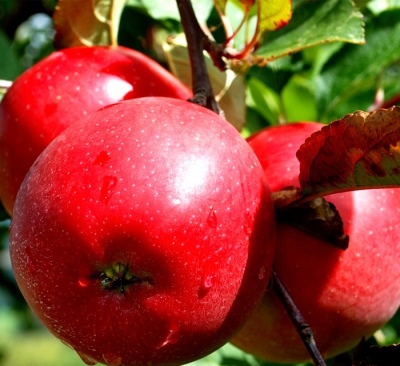
- Authors: selection of the Sverdlovsk experimental gardening station, author - L.A. Kotov
- Taste: sweet and sour, good
- Fruit weight, g: from 100 to 180
- Fruit size: average and above average
- Yield: high, 145-155 kg per tree
- Frequency of fruiting: there is a tendency to periodicity
- The beginning of fruiting varieties: for 5-6 years
- Ripening terms: late summer
- Removable maturity: mid to late August - early to mid September
- Keeping quality: at low temperatures can be stored until March
An important vector of apple growing in recent decades has been the development of varieties suitable for particularly harsh growing conditions. This is exactly what Nastenka's apple tree is like. It has a number of advantages, but there are also some weaknesses, so you should get to know the culture better.
Breeding history of the variety
Nastenka was trained at the Sverdlovsk Experimental Gardening Station. The well-known breeder L.A. Kotov took over the project management. Basic grade - Anise purple. It was artificially pollinated with a combination of pollen from the varieties Rainbow and Samotsvet. Grade tests were carried out in 1992. Despite a good overall result, they were not completed.
Description of the variety
The height of Nastenka at the peak of development is 4.5-5 m. It is characterized by a crown in the form of a reverse pyramid with rarefaction. Other important manifestations:
medium-sized leaves are dark green in color;
the edges of the foliage are jagged;
a matte sheen is noted on its surface;
branches are straight, departing from the trunk at an angle of at least 40 and no more than 65 degrees;
small saber-shaped stipules;
the branches are covered with a brown bark, which is actively peeling;
erect shoots, moderately thick, brown, with noticeable pubescence.
Features, pros and cons
The crown of this variety is sparse. Without additional shaping procedures, the plant can easily rise up to 6-7 m. Nastenka's root system is powerful and goes deep. Therefore, planting it in places with high standing groundwater is not the most worthy idea.
Nastenka's advantages are the large size of the fruit. It is also characterized by excellent productivity. It is worth noting the attractive climatic characteristics. However, the plant is not resistant to scab, especially during wet seasons. In addition, the fruit will appear irregularly.
Ripening and fruiting
Nastenka is a prominent representative of late summer cultures. Removable ripeness of apples is achieved from mid-August to mid-September. The consumer period is until January. The first fruits will appear at 5-6 years of development. However, the frequency can confuse all the cards for gardeners.
Growing regions
This apple tree is a real all-rounder in terms of cultivation places. Its usual areas are the Urals and Siberia. But in practice, it turned out that, in addition to the officially zoned territories, the culture can be successfully grown in:
Crimea;
Moscow region;
Volga region;
Leningrad region;
Central Black Earth Region;
other areas of the European part of Russia, even located quite far to the north.
Yield
There are no exact figures for fruiting. The reason is simple - the very irregularity of cultivation. Another serious problem is that Nastenka's apple tree is grown in various regions. And therefore, its practical results can vary greatly even in the same year.
Fruits and their taste
Universal apples are one-dimensional. It can range from a flat roundness to a rounded cone. The greenish flesh is moderately firm. The peel is smooth, has a gray waxy bloom. Other fruit features:
fruit weight - from 100 to 180 g;
sweet and sour taste;
pleasant juiciness;
the proportion of dry soluble substances up to 15.2%;
the proportion of sugars is from 10.7 to 12.2%;
vitamin C content from 18.9 to 25.4 mg for every 100 g;
the ability to store at low temperatures until early March;
range of tasting ratings from 4.65 to 4.69 points.

Growing features
The apple tree Nastenka is partially self-fertile. For a normal harvest, it is required to plant other trees nearby with the same ripening and flowering period. In the lowlands, this culture takes root with great difficulty. Shady areas are also not suitable for growing it. It is also worth making sure that the soil is not acidified; in some cases liming helps, but it is much easier to simply choose the appropriate place initially.
The planting hole should be up to 0.5 m deep. The dug soil is partially mixed with organic fertilizers and returned back. The sand is improved by the addition of clay containing vegetation residues. The root collar should rise about 3 cm above the ground. Immediately after planting, the apple tree is watered abundantly using 30 liters of water per tree.



Top dressing
It is preferable to feed Nastenka with natural substances. This work is carried out twice a year - in the autumn and spring months. Top dressing is carried out from the second year of planting. In the spring, nitrogen mixtures are used, in the fall, humus is used for digging in the near-stem section.



The apple tree is a popular fruit crop among gardeners. It can be found in many summer cottages. But at the same time, such trees are often affected by various diseases. It is very important to recognize the disease in time and carry out the necessary procedures for a speedy recovery.Otherwise, the fruits will be spoiled, and the tree itself may die altogether.

Review overview
The ratings note:
ease of care;
ease and duration of storage of fruits;
the ability to process apples into delicious juice or aromatic jam;
pleasant fresh taste;
superiority over many other varieties.











































































